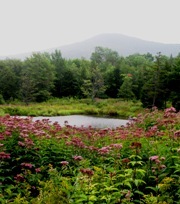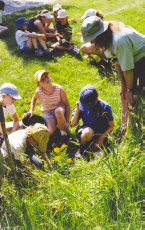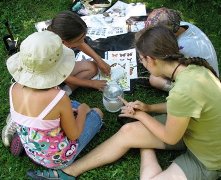

The first section is about three nature preserves in Montgomery, Vermont and some personal background that relates to my work in conservation and environmental education. Some of the text is in French.
The second section has information pertaining to the Nordic countries (Norden), emigration, assimilation and the preservation of the Nordic heritage in the United States.

I am a conservation steward of part of a beautiful landscape in northern Vermont. I spent many years studying what was there and what had happened to this place before I came on the scene - before doing anything at all. I spent many hours watching the beaver in their ponds, built where cows once grazed. They eventually grew accustomed to me, especially to my scent which lingered on freshly cut poplar saplings which I left by the pond's edge.
In bringing back the orchard and the meadows, bluebirds and butterflies returned in great numbers. I left numerous tall trees (some dead, most alive) for raptors to perch and other birds to find cavities for nests. There are even more wetlands now which support many amphibians. The black bear love all the beech trees at the base of the mountain. The bobcat finds shelter and privacy among the rocky outcrops and caves. The meadow and its edge are maintained in succession "layers" which provide food and cover for so many species.
It's fun to pay special attention to the smallest details in restoration work. However when I look at the habitats that I am working to improve, I try to look at the work from a landscape-scale. This means taking a broader view, not just in terms of area, but also in terms of natural systems. We often first perceive nartural areas as homes to one or another animal just as we think of our own homes as unique territories with occasional visitors. Species diversity is wonderful when you can find it. It can also be encouraged. Through plant succession, and natural and human disturbance, habitats evolve. The species mix each area supports can change with the changes in the land. I have achieved the best results when I let the site conditions direct the habitat management plan. And always seek diversity.
Visit the Hazen's Notch Association. See and learn about our conservation land stewardship. hazensnotch.org

The fascination with nature for most people begins at a very young age - with the flight of an insect, the smell of a flower, the feeling of a tree's rough bark as you climb, the sound of a startled squirrel, the sight of a cloud's shadow moving across the ground.
No matter how many years go by since those wonderful summer days at Grassy Hill, Painter Hill, and Steep Rock, it's the memory of those early experiences as a young person which continues to inspire our philosophy of teaching children about nature and their place in it. After the wonderful self-discovery in the woods and old meadows of Woodbury, exploring through the Litchfield Hills, learning mountaineering skills at NOLS in the Rockies, I spent over a dozen years guiding people through the mountains and lakes of the northeastern USA, teaching what I knew of living and traveling safely in wild areas.

My inspiration for creating a nurturing outdoor learning environment for children came from Dr. Mitchell Gratwick of Roxbury, Connecticut. The passion for teaching outdoor skills and teaching methodologies came from William Garrison. Paul Petzoldt created NOLS which gave me the wilderness living and travel skills and the desire to be a mountain guide. Getting to know Paul Petzoldt personally and reintroducing him in 1984 to NOLS which he founded in 1965 was satisfying for me. This enabled me to show my gratitude to the person who meant so much to my most important training. After many years of guiding and teaching adults, now I have come full circle and mostly teach young people about their natural world. It is incredibly satisfying, and I believe, important work. I know that we are making a difference in the lives of young people.
- Rolf Anderson
Visit the Hazen's Notch Association. See and learn about our environmental education programs. hazensnotch.org
 Harvest Moon > 09.22.18
Harvest Moon > 09.22.18